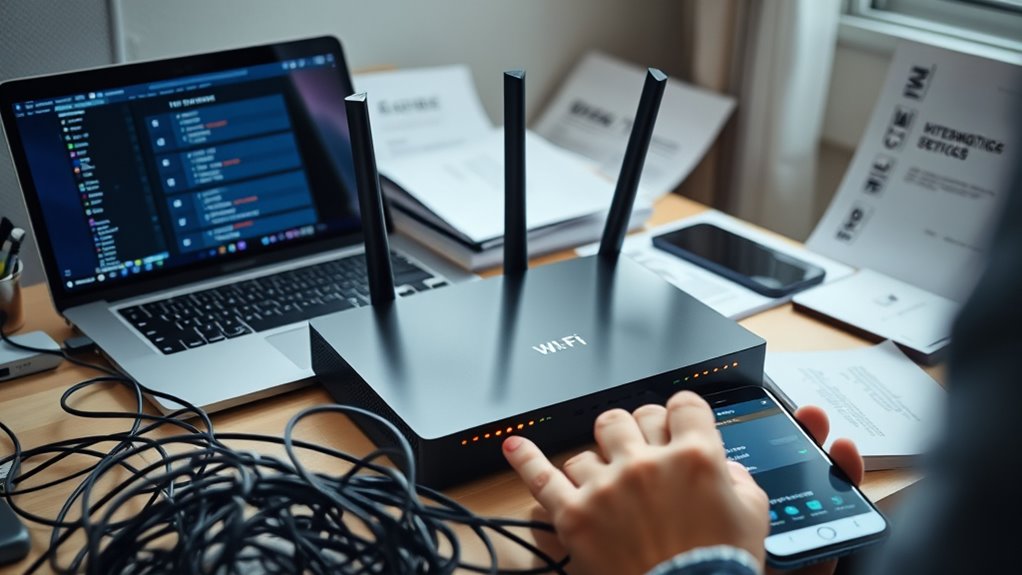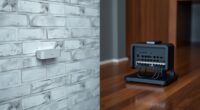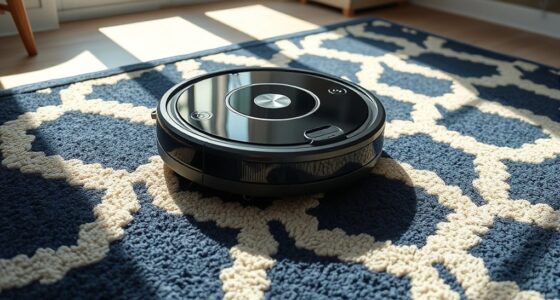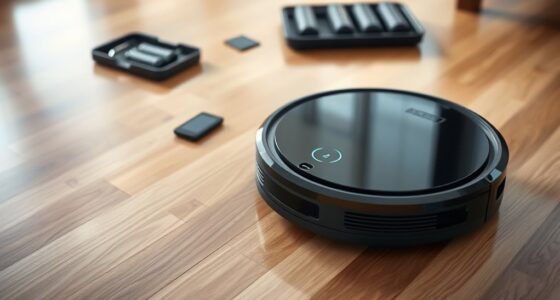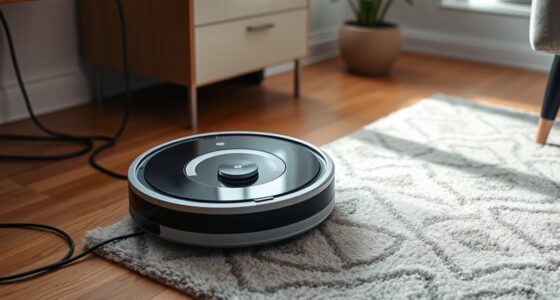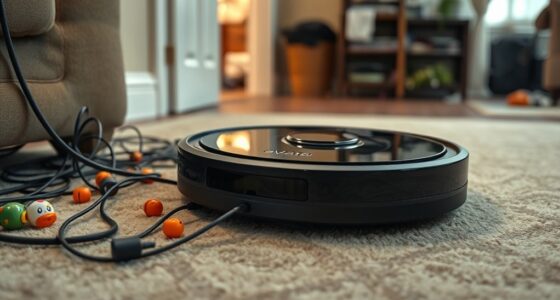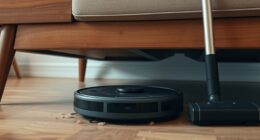To resolve Wi-Fi connectivity issues, start by placing your router in a central, elevated spot away from walls and obstacles. Keep it clear of interference sources like cordless phones and microwaves, and switch bands if needed. Reposition it to avoid thick walls or metal objects that block signals. Updating firmware and changing channels can also help reduce congestion. For persistent problems, using extenders or mesh networks improves coverage. If you explore further, you’ll find even more tips to strengthen your connection.
Key Takeaways
- Reposition your router centrally and off the floor to ensure even coverage and reduce dead spots.
- Minimize interference by keeping the router away from electronic devices like microwaves and cordless phones.
- Update your router firmware regularly to optimize performance and fix connectivity bugs.
- Change Wi-Fi channels manually to avoid congestion from nearby networks and improve stability.
- Use Wi-Fi extenders or mesh systems to enhance coverage and eliminate signal gaps.
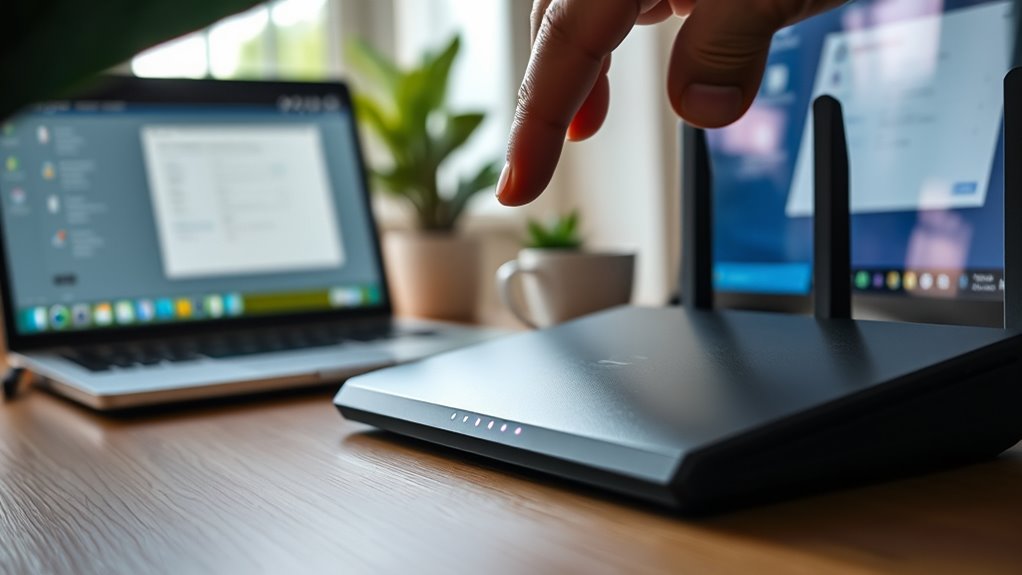
Having Wi‑Fi connectivity issues can be frustrating, but many problems are easy to fix with some simple troubleshooting. One of the first things to check is your router placement. If your router is tucked away in a corner, hidden behind furniture, or placed on the floor, it can weaken your signal and cause slow or dropped connections. To improve your Wi‑Fi performance, position your router in a central, elevated location, ideally on a shelf or mounted high on a wall. This allows the signal to spread evenly throughout your space, reducing dead spots and boosting overall speed.
Proper router placement enhances Wi-Fi coverage and speed.
Another common cause of Wi‑Fi problems is interference sources. Electronic devices like cordless phones, microwave ovens, baby monitors, and Bluetooth gadgets can operate on similar frequencies as your Wi‑Fi, disrupting the signal. Keep your router away from these devices whenever possible. It’s best to place it at least a few feet away from such interference sources. Also, Wi‑Fi operates on 2.4 GHz and 5 GHz bands, and some devices may interfere more on one band than the other. If you’re experiencing persistent issues, try switching your router to a less congested band, or update the firmware to optimize performance.
Wi‑Fi interference isn’t limited to electronics. Thick walls, metal objects, and mirrors can obstruct or reflect Wi‑Fi signals, leading to weaker connections. If you notice your signal drops in certain areas, consider repositioning your router to minimize obstacles. Removing or repositioning metal objects and thick walls can make a noticeable difference. Using Wi‑Fi extenders or mesh networks can also help expand coverage and improve signal strength in areas where the original placement isn’t effective.
Additionally, check for nearby Wi‑Fi networks that could be creating congestion. If many networks in your vicinity are operating on the same channel, it can cause interference, slowing down your connection. Many routers allow you to change channels manually—experiment with different options to find the clearest one for your environment. This simple step can profoundly improve your Wi‑Fi stability.
Frequently Asked Questions
Can Wi-Fi Issues Be Caused by My Internet Service Provider?
Yes, Wi-Fi issues can be caused by your internet service provider. If you’re experiencing internet outages or service disruptions, your Wi-Fi connection might drop or slow down frequently. These problems often stem from ISP network maintenance, technical faults, or high traffic. Check your provider’s status updates or contact their support to see if outages are affecting your area, and wait for them to resolve the issue before troubleshooting your devices.
How Do I Update My Router’s Firmware?
Think of your router as the brain of your network; keeping its firmware updated is like giving it a fresh set of instructions. To perform a router update, log into your router’s admin panel, find the firmware or update section, and follow prompts for a firmware upgrade. Always guarantee you’re connected to a stable internet connection and download updates directly from your device manufacturer’s website for safety.
What Security Settings Can Interfere With Wi-Fi Connectivity?
You should check if your Wi-Fi encryption settings are compatible with your devices, as mismatched encryption like WPA2 or WPA3 can block connectivity. Additionally, firewall settings may be too strict, preventing devices from accessing the network. Adjust these security settings carefully, ensuring they don’t interfere with your Wi-Fi connection. By reviewing Wi-Fi encryption and firewall configurations, you can prevent security features from disrupting your internet access.
How Do I Test Wi-Fi Signal Strength Accurately?
Imagine your Wi-Fi signal as a delicate dance, and you want to see its true rhythm. To test signal strength accurately, you need reliable testing tools like signal strength measurement apps or network analyzers. These tools act as your detective, revealing the real story behind your connection’s strength. By analyzing the data they provide, you can identify weak spots and guarantee your Wi-Fi performs at its best, no matter where you are.
Are There Specific Devices More Prone to Wi-Fi Connectivity Problems?
Certain devices tend to experience more Wi-Fi connectivity problems due to issues like device compatibility and signal interference. Older smartphones, tablets, and smart home gadgets often struggle with newer routers or crowded networks. Devices with outdated network adapters or incompatible hardware may disconnect frequently. To improve connectivity, verify your device supports your Wi-Fi standards, minimize signal interference from other electronics, and keep your device’s software up to date.
Conclusion
Don’t let Wi-Fi woes dim your digital world. Think of your connection as a fragile thread—gently mend the knots, clear the storms, and you’ll restore the flow of your online life. With patience and a few simple steps, you’ll reignite that invisible bridge, reconnecting you to the endless universe at your fingertips. Remember, every fix is a beacon guiding you back to seamless browsing, turning frustrating blackouts into a steady stream of possibility.
